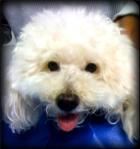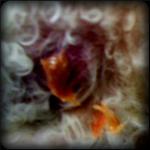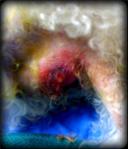6-Year Old Bichon Frise Suffers Bump Under Tail
Bennie had a bump. A red, painful swollen lump under his tail, just to the left side of his anus. He was miserable!
“Doctor, he was perfect yesterday. Now I see this lump and he doesn’t want to eat today,” said Bennie’s human mom.
Doc Truli responded,”Bennie has a blocked, infected left anal sac, that is about to rupture through the skin.”
“What?” said Bennie’s mom.
Okay, most people do not know about this secret of dog (and cat, and ferret, etc) anatomy. Doc Truli might have paused before signing up for veterinary school if she knew a proportion of each and every workday would be spent examining, feeling, and emptying anal sacs. This is a disgusting, soul-trying part of the job of being a veterinarian.
Here’s the “dirt.”
The anal sacs are 2 pouches under the skin at about 5 o’clock and 7 o’clock next to the anus of the cat or dog. The pouches are lined with cells that produce a foul-smelling liquid. The pouches connect up to the edge of the anus via thin tubes called ducts. Each time the dog or cat defecates, the muscle pressure should squeeze the liquid out of the pouches into the bowel movement. This added smell leaves a scent marker for other animals to understand sexual receptivity, health status, and who knows what else animals know? Think of it as “doggie email.”
Now, in some pets, the anal sacs are not normal. (say it slowly and carefully. In fact, most veterinarians call them anal glands. They are not glands, in the proper sense of the scientific word, but then, there is not misunderstanding or mispronunciation. You can imagine the offense someone might take if you say “anal sacs” too quickly!)
If a pet is fat or has neurological or muscular disease, the anal sacs may not express well with each bowel movement. Monthly cleaning out at the vet’s office can help. Some pets develop allergies and the sacs fill up too quickly, or the small ducts become inflamed and swollen shut. The liquid may explode the sac through the skin, instead of the duct. Or, E. coli or other infectious bacteria might infect the sac through the duct and cause an anal sac abscess, like Bennie’s.
“I suspect that anal sacs do not function as nature designed in many of today’s dogs, because the dogs have not mated based on biology and picking each other by smell and individual analysis. Instead, humans have selected dogs for looks and personality and working traits that we humans understand. I doubt anyone has ever picked a stud dog based on the fine chemical analysis of his anal sac contents!” says Doc Truli.
Bennie was sedated, his anal sac was expressed. The duct was patent (not blocked). The area was treated. After the minor surgery, the area looked worse than before!
The sac needs to heal by finding the shattered pieces of the wall of itself and reforming a pouch under the skin. The swelling and inflammation will go down once the liquidy, chunky antigenic material from the cystic pouch is removed by the doctor.
You can imagine the pain associated with this condition! Anti-inflammatory prescription painkillers, and warm water compresses for 5-10 minutes twice a day for a few days will help Bennie heal faster and help with the pain. An elizabethan “cone collar” will keep Bennie from licking and chewing the sore area while it heals.
Sometimes, the anal sac does not heal properly and the condition can recur, necessitating a surgery called an anal sacculectomy. Delicate, important nerves and blood vessels travel under the skin just next to the anus, where the anal sac lives. Therefore, surgery must be carefully considered for pros and cons. A small percentage of dogs undergoing anal sacculectomy surgery become fecally incontinent afterward.
Bennie felt fine. His anal sac healed in under the expected two weeks and he is back to normal.
P.S. *Bonus Question* Do you know the name of the sense organ dogs and cats use to perform a complex chemical analysis of smells like urine and poop? (Hint, in some dogs and cats, the incisive duct leading from the midline of the palate just behind the incisors up to the septum of the nose where it lives is vestigial and does not function.) Click here for Bonus Question Answer.
P.S. May 2010: Check out more bump and mupm stories under the “Bump” tag!






Wow, that is gross. Hope it never happens to my dogs.
Barb,
I hope your Bichons stay healthy, too. The good news is, most ruptured anal sacs heal completely. A small percentage of the time, they do not heal well and major surgery to remove the faulty anal sac is required.
Wishing you happy, healthy Bichons!
-Doc Truli